Civil War
Causes
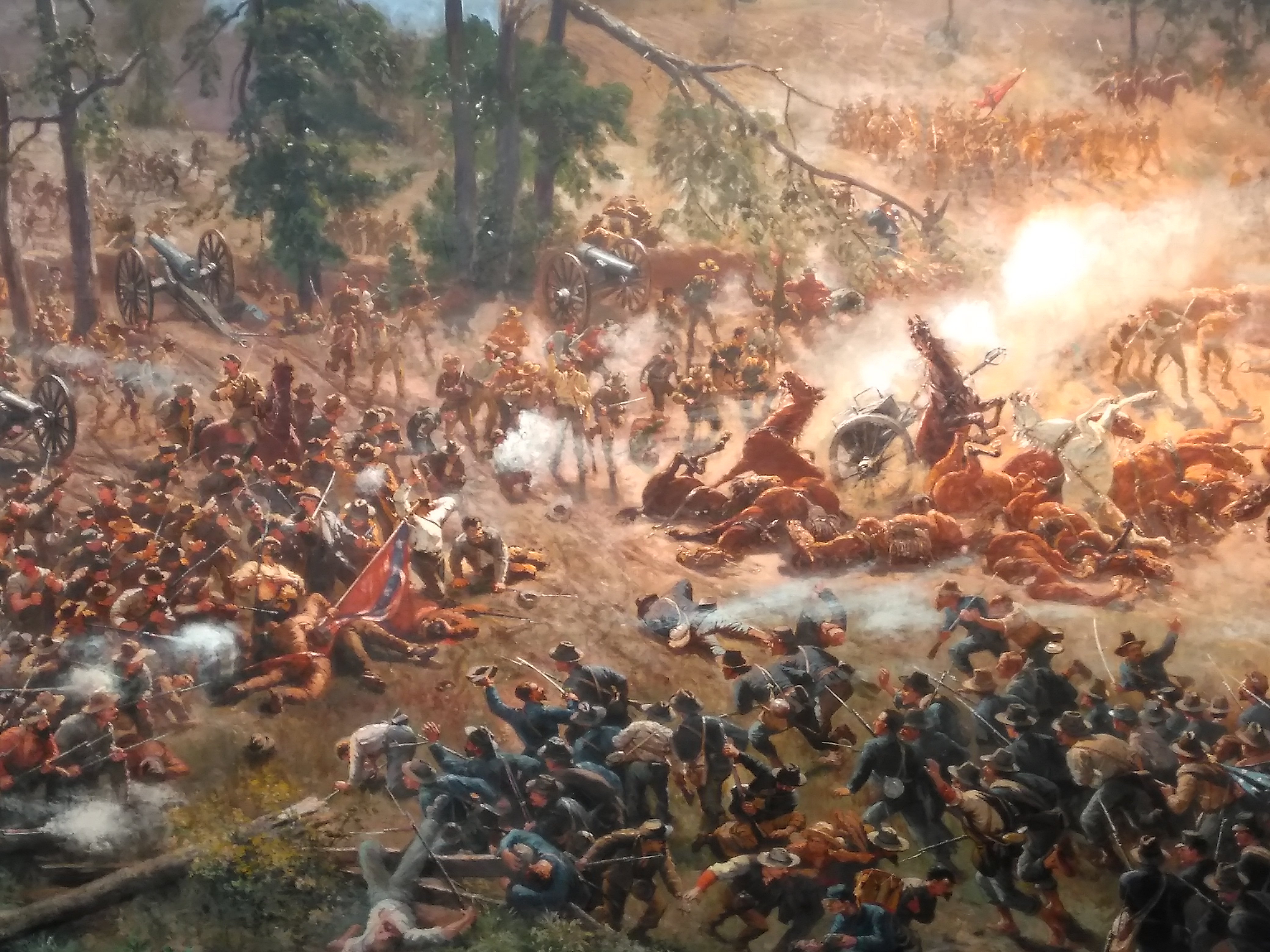
Before the Civil War actually began, the North and the South were growing apart. There were differences that kept getting bigger. Things kept getting worse. The North and South were different in certain ways.

Different Ideas of the North and South
Type of government and control that they wanted
Thinking on slavery
Types of farming
Industry and factories
| Ideas |
North Wanted |
South Wanted |
| Government |
Stronger federal control |
Stronger state control |
| Slavery |
More and more against it |
Plantations needed labor |
| Farming |
Many small farmers |
Many plantations |
| Factories |
Many cities and factories |
Not many factories, more farming |
The ideas grew farther and farther apart. The North wanted the federal government to have more power. The South wanted to let states have greater control. This was most true on the question of slavery. As new states came into the nation, they had to decide whether they would allow slavery or not.
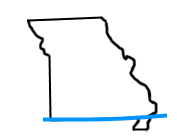
By 1819, Missouri wanted to become part of the United States. It was big enough to be allowed in as a new state. It just had to be approved. At the time there were 11 slave states and 11 non-slave states. Members of Congress that were for slavery wanted to allow Missouri into the Union. Members of Congress who were against slavery did not want Missouri to come in as a slave state. A compromise was made. Congress decided to allow Missouri in as a slave state at the same time as Maine was allowed in as a free state. This agreement was called the Missouri Compromise. As part of the agreement a line was drawn on the 36º 30' latitude. Northern states that were new would be free states. Southern states would be slave states. [1]
The country at this time was expanding west. New territories were being started. Then, before long, those territories wanted to become new states. Political leaders tried to decide what to do. As time went on they thought of new ways to do things. Leaders thought that they should let the new states decide. Letting a state decide about whether it would allow slavery is called popular sovereignty. Popular sovereignty meant that a state, or the people in that state, would be able to decide whether they would be free or slave. California came in as a free state. Texas came in as a slave state. [3]

Finding workers for southern plantations was a growing problem at that time. The large farms in the South were called plantations. There were many of them in the South. Before this time, many land owners got indentured servants. Indentured servants were hired for a set number of years. Often it was for five to seven years. An owner would get indentured servants by paying the persons passage to this country. The owners would provide food and lodging in exchange for the servants work. Owners would then train the servants on their duties. There were some problems with hiring servants. Some indentured servants ran away. They would also get sick. Some died. When their servants ran away, got sick, or dies, the owners would have to find someone else. Then owners would have to train new servants. Finding runaway indentured servants was hard to do. They were usually white and mixed in well with the other whites in nearby communities. [1] So while many land owners hired servants, this method had its problems.

As early as 1619, Dutch slave trade arrived at our shores. Dutch slave traders brought 20 slaves to Jamestown, Virginia. After that, the traders kept coming and selling. If a land owner bought slaves, they would not lose them after a few years. This was better than with indentured servants. The Africans were black skinned. This made them easier to find if they ran away. [3]
At this same time, many factories were being built in the North. Industry was growing quickly. Cities made this growth possible. The South stayed mostly more rural. City life of the North and country life of the South made people think very differently.
What happened with cotton was also important about how our country developed. In the 1700s producing cotton was expensive. It was hard to remove the cotton fibers from the seeds. Slaves would pick the cotton during the day. At night they would sit outside their cabins around a log fire and separate the seeds from the cotton fibers. Getting the seeds out of the cotton took a lot of time. It was a lot of work. [2] On many plantations, when the cotton was separated from the seeds the cotton was taken up to the “big house” and made into yarn. Then it was woven on a hand loom. Some cotton was shipped to New England. Textile mills wanted more cotton. Then the machine for taking the seeds out of cotton was invented everything changed.
The story about what happened to cotton took place on the Mulberry Grove Plantation in Georgia. The owner was the widow of General Nathanael Greene. General Greene had been a leader in the Revolutionary War. A plantation was given by the state of Georgia to General Greene for his service in the war. Mrs. Greene ran the plantation with the help of 50 servants and slaves. One of the crops they raised was cotton.
A young man named Eli Whitney was moving to South Carolina to teach school. On his way to his new job he met Mrs. Greene. She invited him to stop and visit her before going to his new job. One night Mrs. Greene was talking with some of her visitors about the problem of separating the seeds from cotton. Before that night Mrs. Greene had seen Mr. Whitney make some very clever toys for her children.
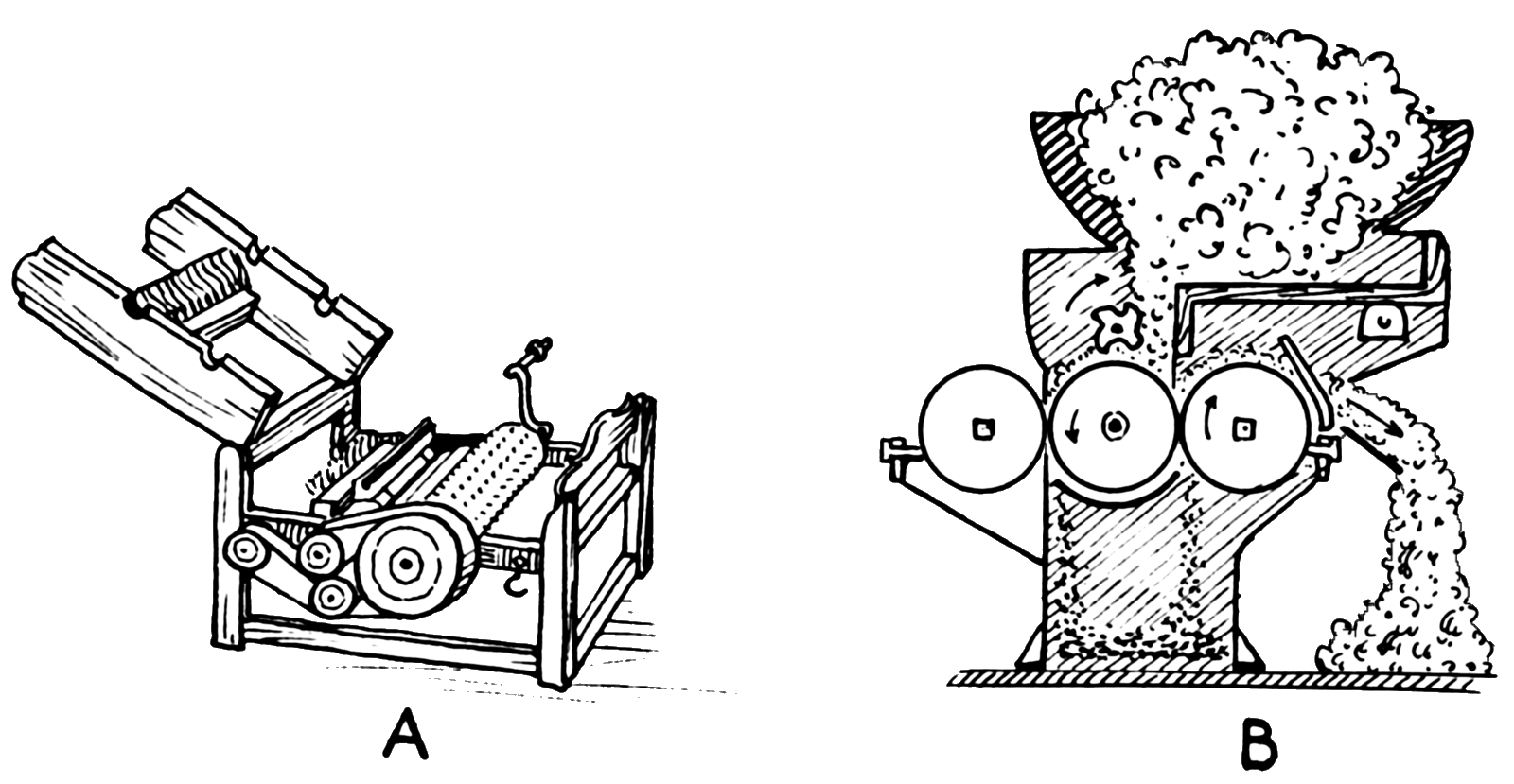 She could see he was good with mechanical things, so she called Mr. Whitney from his room. She wanted to talk with him about the cotton-seed problem. As a matter of fact, he had already been working on the problem. After their talking that night, a work shop was given to Mr. Whitney. He continued to work on the removing the cotton seed problem. In a short time he created a machine they called a cotton gin. The machine would clean as much cotton in a day as fifty men could do it before. [2]
She could see he was good with mechanical things, so she called Mr. Whitney from his room. She wanted to talk with him about the cotton-seed problem. As a matter of fact, he had already been working on the problem. After their talking that night, a work shop was given to Mr. Whitney. He continued to work on the removing the cotton seed problem. In a short time he created a machine they called a cotton gin. The machine would clean as much cotton in a day as fifty men could do it before. [2]
Factories, where large looms were located, were hungry for cotton. Before the cotton gin it took 10 hours to produce or make a pound of cotton. With the cotton gin thousands of pounds of cotton could be produced in a day. The year the cotton gin was invented 138,000 pounds of cotton was exported.
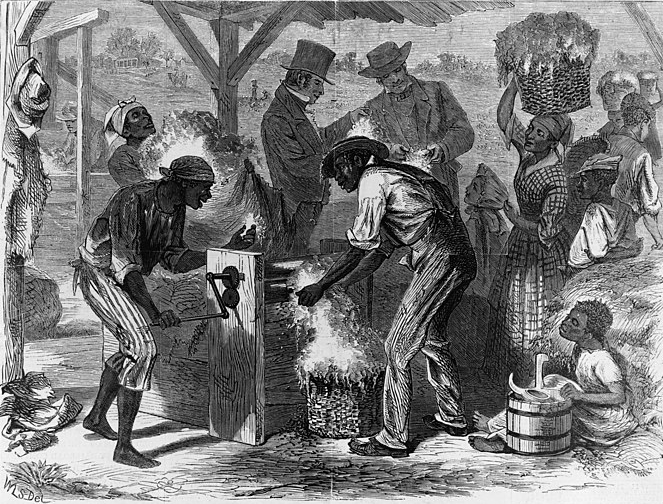 Two years later 1,600,000 were exported. This was more than 10 times the amount that was exported before.
Two years later 1,600,000 were exported. This was more than 10 times the amount that was exported before.
Early leaders of our country had felt that slavery would die out eventually. The cotton gin changed how that would play out. The cost to produce cotton got much, much cheaper. When that happened the need for labor grew. Northern factories wanted more cotton. Southern plantations then wanted more slaves. Cotton became central to both the southern and northern economies. Cotton became King.
The issue of slavery was a cause of the Civil War. African Americans struggled mightily against it. Government leaders talked about it a good deal. But, they often avoided the question. A good portion of the American economy was tied to slavery. This was true both in the South and the North. Northern factories benefited from cheaper cotton. [4][5]
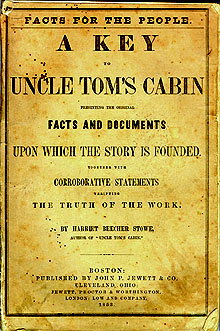
Uncle Tom’s Cabin by Harriet Beecher Stowe was a book about slavery. It was a novel that told about how bad slavery was. It was a book that many Americans read. It got many people thinking about slavery. This book stirred up trouble between the North and the South. In the north it made people mad that we allowed slavery in this country. In the south it made people mad because the book spoke against slavery. It did not tell their side of the story.
Harriet Stowe was born in the north. She became an abolitionist and heard examples of slavery from run-away slaves that made it to the north. There is a story that Abraham Lincoln at one time asked Stowe if she was the one that started the Civil War because of her book. [6]
John Brown’s Raid got many people worried and upset. John Brown was an abolitionist. He wanted to stop slavery. He wanted to help slaves become free. One thing he did was that he organized an attack on the town of Harper’s Ferry, Virginia. Harper’s Ferry was a federal arsenal. That is a place where the government stores weapons and ammunition. It had a large amount of guns. He got a group of 18 men to go there and capture the guns and ammunition. The idea was that they would arm the slaves. That meant they would give weapons to the slaves. John Brown thought that if they armed a group of slaves that more would come and join them. Then he planned to move south with a growing army of slaves. If enough came they could protect themselves and gather more.
The plan did not work. Not enough former slaves gathered with them. Local citizens and militia surrounded the raid party. Then federal troops were sent in to help. The troops, led by Lieutenant Colonel Robert E. Lee, attacked the place where the group was gathered. John Brown and his raiders were quickly captured. Brown was tried in court and sentenced to hang.
The raid was not successful, but the effect was strongly felt on the country. It made more people take sides about slavery. Many northerners were happy that the raid happened. Many southerners were mad. People were becoming more and more angry with each other over slavery. [7]

Reading resources
© Reading-SocialStudiesSolutions
Text Credits:
[1] Common Core Achieve Social Studies;
[2] The Story of Louisiana by William O. Scroggs pp. 210, 211;
[3] http://www.ushistory.org/us/;
[4] http://www.ushistory.org/us/27a.asp;
[5] A Slave No More by David W. Blight;
[6] http://www.ushistory.org/us/28d.asp;
[7] http://www.ushistory.org/us/32c.asp
Image Credits:
Cyclorama picture of Confederate and Union soldiers fighting for position in the battle for Atlanta at Atlanta History Museum in May 2019;
Solider-Bayonet Pearson Scott Foresman 2 Wikimedia Commons 800 px;
State image of Missouri drawn from National Atlas.gov- Wikimedia Commons;
Servant-yes-madam by bf5man- Openclipart.org;
A Slave Ship - Africa and the American Flag - BritishLibrary - Foot 1854 p038 - Wikimedia Commons;
Cotton Gin 2 by Pearson Scott Foresman- Wikimedia Commons;
Uncle Tom's Cabin - cover by Harriet Beecher Stowe- Wikimedia Commons;
Cotton Gin and African American Labor by William L Sheppard and Harpers Weekly through Library of Congress- Wikimedia Commons
 She could see he was good with mechanical things, so she called Mr. Whitney from his room. She wanted to talk with him about the cotton-seed problem. As a matter of fact, he had already been working on the problem. After their talking that night, a work shop was given to Mr. Whitney. He continued to work on the removing the cotton seed problem. In a short time he created a machine they called a cotton gin. The machine would clean as much cotton in a day as fifty men could do it before. [2]
She could see he was good with mechanical things, so she called Mr. Whitney from his room. She wanted to talk with him about the cotton-seed problem. As a matter of fact, he had already been working on the problem. After their talking that night, a work shop was given to Mr. Whitney. He continued to work on the removing the cotton seed problem. In a short time he created a machine they called a cotton gin. The machine would clean as much cotton in a day as fifty men could do it before. [2] 




 Two years later 1,600,000 were exported. This was more than 10 times the amount that was exported before.
Two years later 1,600,000 were exported. This was more than 10 times the amount that was exported before. 
